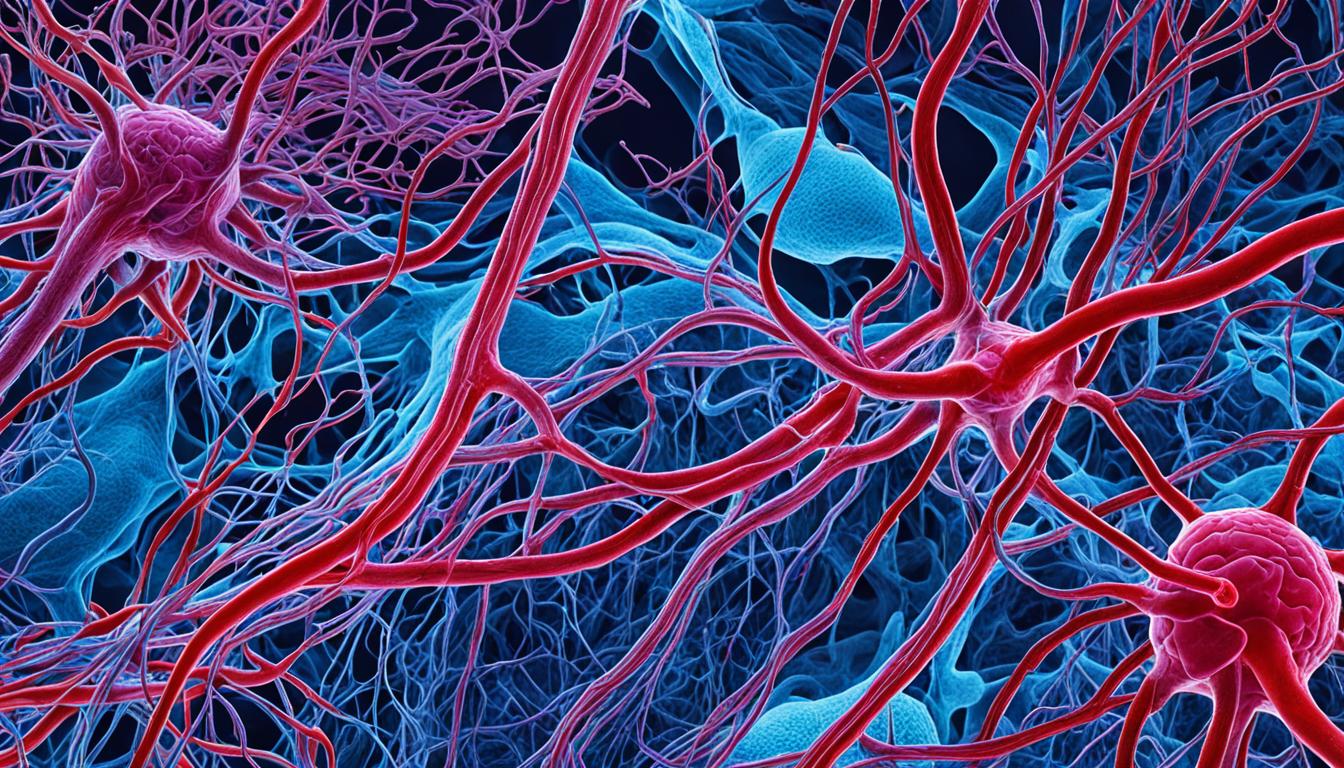A brain arteriovenous malformation (AVM) is a complex knot of blood vessels in the brain. It messes up blood’s natural course in the brain. This problem, though rare, leads to various signs like headaches, seizures, and even vision issues. Some might experience muscle weakness.
It can either be there from birth or show up later in life. The reasons why it happens are not fully understood yet. But, it could run in families. Getting diagnosed early is really important. It helps avoid severe problems like brain harm or strokes.
There are different ways to treat brain AVMs, such as surgery and other less invasive methods. These include embolization and radiosurgery. Moreover, scientists are looking into using stem cell therapy as a new treatment method.
Key Takeaways:
- A brain AVM is a tangle of blood vessels in the brain that disrupts normal blood flow.
- Symptoms of brain AVMs can include headaches, seizures, muscle weakness, and vision loss.
- Brain AVMs can be present at birth or develop later in life, and hereditary factors may play a role.
- Early diagnosis is crucial to avoid complications like brain damage or stroke.
- Treatment methods include surgery, embolization, and radiosurgery.
- Stem cell therapy is being explored as a new approach for treating brain AVMs.
Symptoms and Complications of Brain AVM
Brain AVMs can show many symptoms that differ in how severe they are. The kind and place of the AVM affects what symptoms you might have. Brain AVM symptoms often involve:
- Seizures
- Headaches
- Muscle weakness
- Vision problems
These symptoms are due to the unusual blood flow and pressure caused by the AVM. If you have any symptoms, it’s important to see a doctor right away. This is to find out the reason and get the right treatment.
Brain AVMs might lead to big health risks. This includes the danger of Brain AVM complications like:
- Bleeding in the brain (hemorrhage): A brain AVM can make the brain bleed without warning. The chance of this happening is about 2-3% each year and can be higher for some AVM types.
- Reduced oxygen supply to the brain tissue: A brain AVM can cut off proper blood and oxygen to the brain, causing lasting harm.
Both bleeding and lack of oxygen can lead to bad outcomes. This could mean temporary problems, lasting disability, or even death.
Brain AVM Bleeding Risk
Many worry about how likely a brain AVM is to bleed. The real risk depends on where the AVM is and what it’s like. Knowing this, it’s key to find and treat brain AVMs quickly.
| Type of AVM | Bleeding Risk per Year |
|---|---|
| Small, superficial AVM | 1-2% |
| Large, deep AVM | 4-5% |
| Aneurysm-associated AVM | 8-12% |
Table: Brain AVM Bleeding Risk by Type
Talking with brain AVM experts is very important. They can check your personal risks and plan the best treatment. Getting treated early can lower AVM risks and help you in the long run.
Diagnosis and Treatment of Brain AVM
Diagnosing a brain AVM involves steps like MRI and CT scans. These tests find the AVM, showing its size and type. Knowing this helps pick the best treatment.
After the diagnosis, treatment choices depend on the patient’s health and AVM’s specifics. A group of experts creates a special plan for each patient. This team includes neurosurgeons and others.
Treatments may be surgery to remove the AVM, or blocking its blood supply. Radiosurgery is another option. It shrinks the AVM with focused radiation. Each of these is designed to match the patient’s needs.
Seeing skilled AVM specialists is key. They offer the right advice and support. With early and right treatment, the chances of getting better are high.

